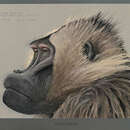Biology
provided by Arkive
The basic unit of gelada society is the unimale family group, consisting of one male and several females and their young (6). Associated unimale groups cluster into bands that may travel in the same area, although membership is flexible and unimale groups have been known to travel with several different bands at different times or even alone (6) (7). Bands in turn aggregate in large temporary herds that come together usually during the dry season for grazing (6) (7). Outside of these social organisations are all-male bachelor groups, which forage on their own and sleep separately from the unimale groups (6) (7). Males from bachelor groups will challenge males of unimale groups for tenure of their harem, and thereby access to breeding females. Within unimale groups, female bonds are very strong, and the females will try to stay together even if the male of their group dies (6).
There is no defined breeding season, but a birth peak has been noted during the rainy season. Females usually give birth to a single infant at a time, after a gestation of five to six months. Females attain sexual maturity at around four or five years of age, whereas it takes five to seven years for males to fully mature (7).
The diet of this species depends on seasonal availability, but consists largely of grasses, with the blades, seeds and bulbs all being eaten (6) (7). Grasses are picked by rapid, dextrous hand movements as the gelada sits and shuffles along the ground (8), but the species is also reported to eat fruit, flowers, leaves, insects (6) and even small mammals (2).
Conservation
provided by Arkive
The gelada is listed on Appendix II of CITES, permitting only monitored quotas of trade between countries. It is also now illegal to hunt, kill or collect the species unless it is by government authority, which is only granted if it is deemed to be in the national interest or for the purpose of science. Additionally, the largest population of geladas exists within the Semien Mountain National Park, which is fully protected (7). Since the gelada is so highly adapted to its unique environment in the cool heights of the mountain meadows of Ethiopia, it is imperative that the conservation of the species focuses on the protection of this remaining habitat. As the last surviving species in a once great dynasty of grass-grazing primates, the gelada is a precious relic of its fossil relatives that we must preserve (4).
Description
provided by Arkive
Although often referred to as gelada baboons, these monkeys actually belong to a separate genus and are not true baboons. They are in fact the only member of their genus and the last surviving species of a once widespread group of grass-grazing primates (4) (5). The gelada can be easily recognised by the unusual hairless patches of skin on the chest, which blaze a bright crimson colour when females are in oestrus. Since this species spends long periods sitting whilst foraging for food, the usual sexual cue of red sexual swellings around the genitals would be difficult to see. Thus, by mimicking these sexual swellings, these more conspicuous chest patches serve as a highly visible signal of sexual receptivity (6). The coat is short and brown with a tuft of hair at the tip of the tail, and the adult male's shoulders are cloaked by a large cape-like mantle or mane (6) (7). The muzzle is deeply grooved with longitudinal ridges, and the upper lip can be everted in flash displays of communication (5), just as the contrasting pale eyelids against the dark face are also used for communicative expression (7).
Habitat
provided by Arkive
Geladas sleep at night on rocky cliffs and outcrops, venturing in the morning to forage in nearby grasslands, mostly between 2,000 and 5,000 m above sea level (7).
Range
provided by Arkive
The gelada is found only in the highlands of Ethiopia, with the majority of the population in the Semien Mountains National Park (2) (7).
Status
provided by Arkive
Classified as Least Concern (LC) on the IUCN Red List (1), and listed on Appendix II of CITES (3). Subspecies: the Northern gelada (T. g. gelada) is classified as Vulnerable (VU) on the IUCN Red List (1).
Threats
provided by Arkive
The fossil group to which the gelada belongs was once widespread throughout eastern and southern Africa, but all except this species vanished as the grasslands upon which they relied shrank (2) (4) (5). Although geladas are still relatively abundant, and classified on the IUCN Red List only as Least Concern, their highly specialised ecology deems them dependant upon their unique environment and thereby vulnerable to habitat change (7). Ethiopia's growing human population and expanding farmlands are therefore putting the species at risk, with fields of crops and pastures of horses and cows now encroaching on gelada terrain (4). Furthermore, geladas have been shot as crop pests by farmers where they have been accused of raiding locally cultivated lands (7).

